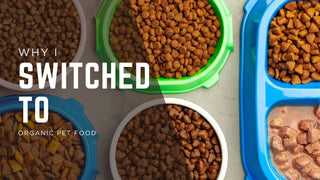I used to buy whatever pet food was on sale. I didn’t think much about what was in it. If it was cheap, easy to find, and my dog ate it, that was good enough for me. I figured all dog food was pretty much the same.
But over time, I started noticing things. My dog, Daisy, had an upset stomach more often. Her fur didn’t shine like it used to. She scratched a lot, and her energy seemed lower. At first, I thought it was just age. She’s not a puppy anymore, after all. But something didn’t sit right with me.
One day, I was cleaning up after her and noticed something odd in her food. I checked the bag and read the ingredients. There were words I couldn’t pronounce. Things like “meat by-product meal,” “artificial flavoring,” and “preservatives.” I didn’t know what most of it meant, but it didn’t sound like real food.
That got me thinking. If I wouldn’t eat food full of chemicals and fillers, why was I feeding it to my dog? That’s when I decided to learn more about what goes into pet food—and that’s how I discovered organic pet food.
What Is Organic Pet Food?
When I first heard the term, I thought “organic” just meant expensive. But it turns out, there’s more to it. Organic pet food is made from ingredients that are grown and raised without harmful chemicals. That means no pesticides, no fake additives, no artificial colors, and no genetically modified stuff.
The meat comes from animals that are raised without antibiotics or growth hormones. The vegetables and grains (if any) are grown naturally. Everything is kept simple and clean.
The more I read, the more it made sense. Organic food is about going back to basics. Real meat, real veggies, and nothing fake.
Why I Made the Switch
I didn’t switch overnight. I was still unsure if it was worth it. But my dog’s health was important to me. I started small. I bought a small bag of organic dog food and began mixing it with her regular food.
I noticed a few changes after just a couple of weeks. Her stools were firmer and easier to pick up. She didn’t have gas as often. Her coat got a little shinier. And she started getting excited about mealtime again. That’s when I knew I was on the right path.
After a month, I made the full switch. No more mixing. She now eats only organic food—and she’s doing great.
The Benefits I’ve Noticed
Here’s what changed after we made the switch to organic pet food:
Better Digestion
Daisy’s stomach used to be sensitive. Some days she wouldn’t eat, or she’d vomit after meals. That rarely happens now. Her digestion has improved a lot.
Healthier Coat and Skin
Her fur feels softer and looks shinier. She used to scratch herself a lot—now she hardly does.
More Energy
She seems more playful. Not like a puppy again, but more alert and lively.
Fewer Vet Visits
She hasn’t had any stomach or skin issues since switching. That’s saved me a few trips to the vet—and some money, too.
What to Look For in Organic Pet Food
When I first looked for organic food, I wasn’t sure what to buy. Here’s what I learned along the way:
-
Look for “Certified Organic” on the label
This means it meets the standards set by organic food agencies. It’s not just a marketing word—it’s checked and approved. -
Read the ingredients
If you can’t recognize the first few items, it’s probably not the best choice. Look for things like chicken, beef, sweet potatoes, carrots, brown rice. -
Avoid fillers and by-products
Stay away from vague ingredients like “animal meal” or “meat by-product.” That just means leftovers and waste from meat processing. -
Choose the right food for your pet’s age and size
Some organic foods are made for puppies, others for seniors. Some are better for small dogs, others for large ones. Pick what fits your pet.
Is It More Expensive?
Yes, it can cost more. I won’t lie about that. But I look at it this way: better food means fewer problems. If I can avoid vet bills or health issues by feeding Daisy something better, then it’s worth it to me.
Also, I noticed she doesn’t need to eat as much. Because organic food is more filling and has more nutrients, she gets full with smaller portions. That helps stretch the bag a bit longer.
And I’m not buying treats or supplements as often. Good food seems to cover a lot of what she needs.
Tips for Switching
If you’re thinking about switching, here’s what helped me:
Go slow
Mix the organic food with your pet’s current food. Start with 25% organic, then slowly increase it over a week or two.
Watch how your pet reacts
Look at their stool, energy levels, and appetite. If anything seems off, talk to your vet.
Stick with it
It might take time to see changes. But once you do, you’ll know you made the right call.
Final Thoughts
I used to think all pet food was the same. I didn’t think about what was inside the bag. But now, I see things differently.
Feeding my dog organic food isn’t just a trend. It’s a choice I made because I care. I care about what she eats. I care about her health. And I care about giving her the best life I can.
She can’t choose her food—I do that for her. And now I choose better. I choose simple, clean, and safe.
If you’re wondering whether organic pet food is worth it, I’d say give it a try. Start small. Watch your pet. See how they respond. You might be surprised, like I was.
Daisy may not know what “organic” means—but I know she feels better. And for me, that’s all that matters.
